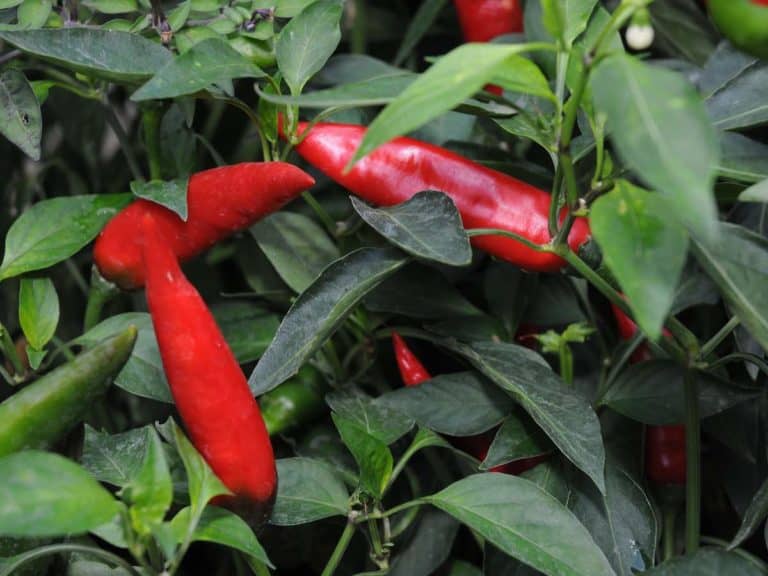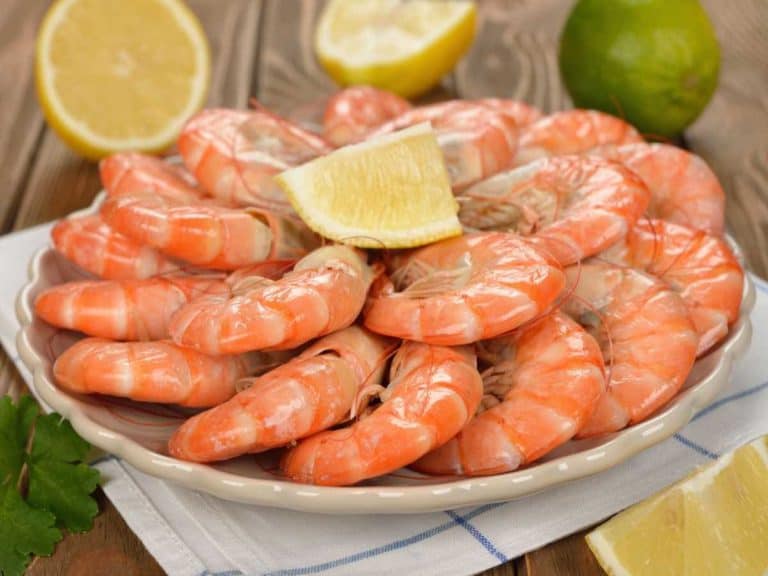Best Dry Red Wines for Cooking Beef
Chefs at high-end restaurants, hotels and casinos often reach for a bottle of dry red wine when making their signature beef dishes. But don’t just go for any dry red wine if you want to impress your family and friends — opt for something that seasoned chefs swear by each and every single time.
Some of the best dry red wines for cooking beef dishes are those with dark- and red-colored fruit flavors and mild to moderate tannins. Acidic ones are great for many hearty beef dishes, especially those with tomato-based sauces. Many dry red wines for cooking beef can be substituted with one another.
Whether a special occasion is nearing or you just want to level up as a casual cook, read on.
Below, we will talk about some dry red wine varieties perfect for cooking all kinds of beef dishes. With the right bottle and the right recipe, you can avoid putting your reputation on the steak!

Sangiovese
Various tomato-based beef dishes can be cooked with a Sangiovese, which is one of the driest red wines on the face of the planet. It can have a rich flavor, too, that can range anywhere from earthy to fruity. Something that’s fruit-forward commonly has cherry flavors with delicate notes of tomatoes.
The fact that Sangiovese is acidic and high in tannins makes the red wine perfect for cooking beef.
In many instances, Sangiovese is considered similar to Cabernet Sauvignon, which we will talk about in a few — don’t stop reading now! While it’s true that these dry red wines share certain things in common, there are also differences between the two that make them shine in their own way and make beef dishes exciting.
Sangiovese, for one, has brilliant tones, which makes it one of the most versatile red wines for cooking. On the other hand, Cabernet Sauvignon is fuller and darker, which is why it’s commonly used for cooking rich and fatty dishes.
It’s important to keep in mind that one bottle of Sangiovese can taste slightly different from another bottle. It depends on where the red wine is produced as well as what it’s blended with. The grapes used for making Sangiovese are native to Tuscany, although varietals are also grown in other regions of Italy.
Needless to say, carefully studying the beef recipe you wish to give a try is a must. But the general consensus is that where there’s red meat and tomatoes, Sangiovese should be there, too.
The following are some beef dishes that can be made richer and more flavorful by the presence of Sangiovese:
- Braised beef
- Tomato-based beef spaghetti sauce
- Italian beef pot roast
Read Also: Best Red Wines for Cooking Spaghetti Sauce
Tempranillo
The vast majority of Tempranillo red wines in the market come from Spain, which usually convey a rather surprising contrast of cherry and leather flavors. Bottles of Tempranillo that come from elsewhere, such as Mexico, Argentina and the US, are usually more fruit-forward, delivering red fruit flavors and tomatoes.
Since it has a somewhat similar taste profile to Sangiovese, it isn’t surprising why Tempranillo can also be used for making an assortment of beef dishes that can be cooked with the dry and highly acidic Italian wine.
Many people can’t help but agree that Tempranillo is also similar to Cabernet Sauvignon, especially one that’s full-bodied. As a matter of fact, both products are used for boosting the fruit taste of other red wines. In some instances, Tempranillo and Cabernet Sauvignon are added to red wines in order to add character and body.
A lot of regional Spanish dishes can benefit from the addition of Tempranillo.
Thanks to its unmistakable savory quality, however, it also works very well with dishes from across the globe. As a general rule of thumb, Tempranillo can be used for whipping up various red meat dishes as well as those with rich tomato-based sauces. The dry Spanish red wine is also perfect as a marinade for grilling purposes.
Besides beef recipes, many that call for the use of lamb and pork also commonly require Tempranillo. It’s not uncommon for you to come across chicken and duck recipes that welcome its addition.
Here are some beef dishes that can become complete standouts with a dash or two of Tempranillo:
- Tomato-based beef spaghetti and pizza sauce
- Spanish beef stew
- Braised beef polenta
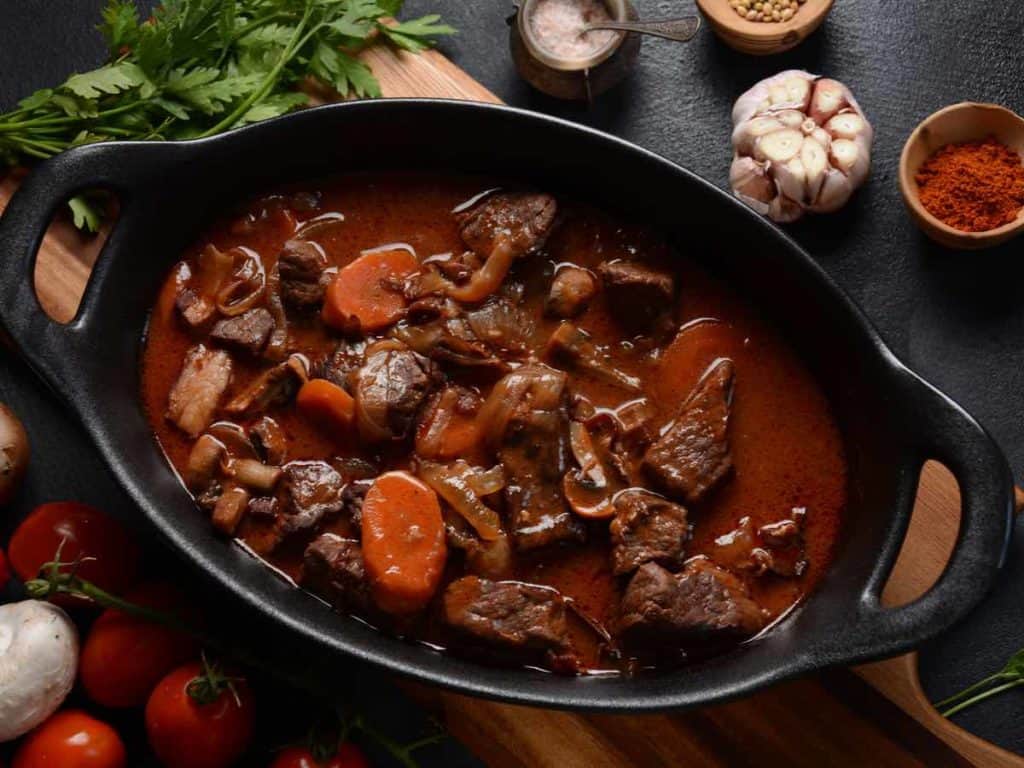
Cabernet Sauvignon
It usually takes only one whiff and sip to reveal the fact that Cabernet Sauvignon is a full-bodied red wine. But unlike most counterparts that are also full and rich, it’s made from a blend of grapes. And it’s exactly for this reason why Cabernet Sauvignon is trusted by many seasoned chefs for balancing out the flavors of rich and fatty dishes.
Originally, Cabernet Sauvignon is from France. These days, however, it’s also being made in many wine-producing countries such as Chile, New Zealand, South Africa, Australia and the US.
Having high acidity and tannin levels is something that makes the red wine great for cooking beef dishes.
While the flavor can vary from one bottle to the next, depending on the origin and blend, Cabernet Sauvignon, generally speaking, boasts of dark-colored fruit flavors. It’s not uncommon for a discerning mouth to pick up blackcurrants, blackberries and black cherries. Hints of green bell peppers, vanilla and tobacco may be present, too.
Because of its rather complex taste profile, Cabernet Sauvignon is one of the best red wines for cooking, especially for the preparation of many meat-based dishes.
There is no denying that Cabernet Sauvignon should be within easy reach if you want to come up with extraordinary beef masterpieces. More often than not, the dry red wine is used for braising and glazing purposes — it’s great for glazing because its low-sugar content can keep it from caramelizing at high heat.
Check out some of the most popular beef dishes that a little (or lots of) Cabernet Sauvignon can make better:
- Beef bibimbap
- Beef bourguignon
- Beef rib roast
Related Article: Best Red Wines for Cooking Chicken
Pinot Noir
Many recipes — beef, pork, lamb, duck, chicken, fish, shrimp, vegetables, etc. — call for the use of Pinot Noir when the addition of red wine is a plus. That’s because it’s smooth and silky, and thus makes for a versatile cooking wine.
In many instances, it’s the go-to wine for tenderizing tough and fatty meats.
Like most other red wines, the taste of Pinot Noir can slightly vary from bottle to bottle, depending on, as expected, where it comes from. These days, the red wine comes from various regions of the planet. However, it’s originally a product of France, with much of its concentration coming from Burgundy, Champagne, Loire and Alsace.
The majority of Pinot Noir in the market has dark- and red-colored fruit flavors. Some of the brightest of the bunch include blackberries, black cherries, red cherries, strawberries and raspberries.
In a hurry to serve something delightful? Then Pinot Noir is not what you are looking for.
More often than not, the dry red wine is used for the creation of dishes that normally take a long time to cook. If something is slow-cooked in order to be rich and flavorful, chances are that Pinot Noir is the perfect bottle to uncork. Also, since it’s on the lighter side of things, it’s not uncommon for recipes to require the use of lots of it — sometimes cups!
When cooking beef with red wine, consider Pinot Noir that’s more tannic. It will be so much better at tenderizing meat and plumping up the acidity of tomato-based stews and sauces.
These are some well-loved beef dishes that Pinot Noir can help elevate:
- Beef tenderloin
- Swedish meatballs with red wine sauce
- Balsamic beef stew
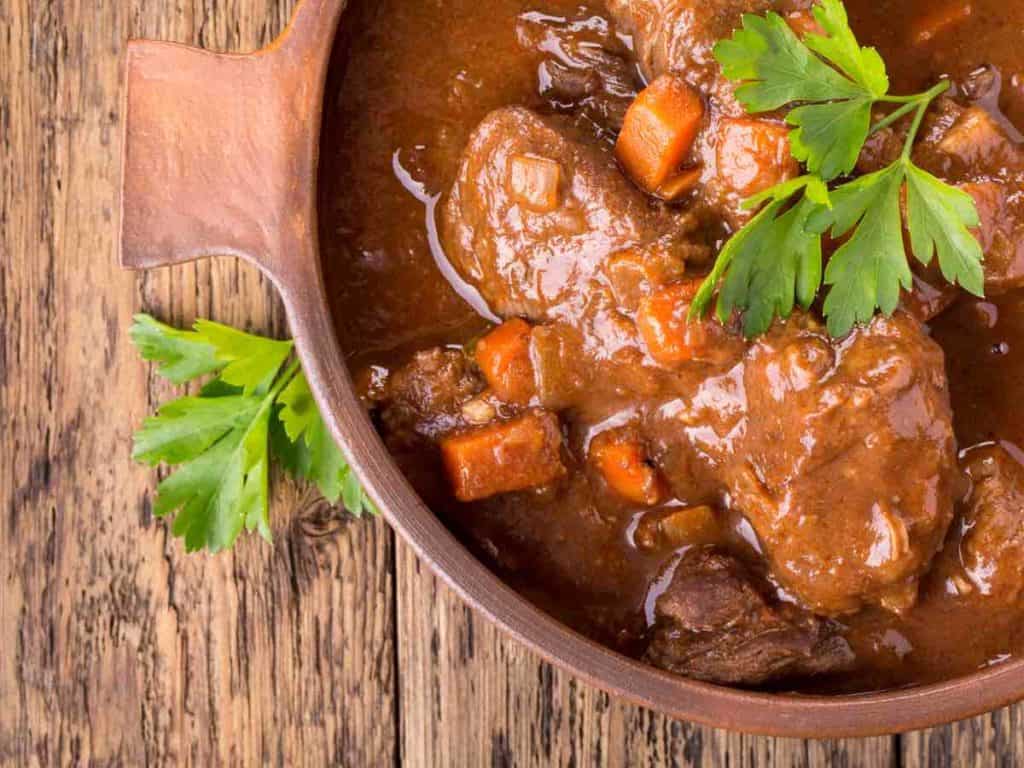
Shiraz (or Syrah)
First things first: Shiraz is the same as Syrah. That’s because both of them are made from the same type of grapes — it’s referred to as Syrah in France, but it’s called Shiraz in Australia. Red wines produced elsewhere that are made from the same grape varietal are referred to as Shiraz, especially if they carry Australia’s own Shiraz style.
When it comes to cooking beef dishes or anything else with meat, you can opt for any of the two.
To most, the difference between Shiraz and Syrah is anywhere from minimal to indistinguishable when used for cooking. Shiraz has a lighter body with finer tannins, while Syrah is slightly fuller and richer.
But because they are from one type of grape, albeit called by different names, it isn’t surprising that the flavor profiles of the two dry red wines are pretty much one and the same. One sip will give hints of blackberries, blackcurrants and raspberries. The detection of pepper, leather, smoke and tobacco can be expected, too.
Compared to most red wines, Shiraz packs more tannins. But that’s okay because it’s exactly what makes the dry red wine a fantastic cooking companion, especially when preparing red meat dishes. The deep and dark flavors of Shiraz also help enrich the flavor profile especially of beef.
If you cannot get your hands on a bottle of Shiraz, you may instead go for Cabernet Sauvignon. While it usually has a stronger taste than Shiraz, it also has notes of smoke and tobacco.
Grenache, Malbec and Zinfandel are also somewhat similar to Shiraz and thus can be used as alternatives to beef recipes — we will talk about these red wines in a few, so read on!
The following are some beef dishes that can be made more unforgettable by the presence of Shiraz:
- Australian beef pie
- Shiraz-braised short ribs
- Slow-cooked beef casserole
Merlot
One of the most popular red wines all over the planet is Merlot. As a matter of fact, it’s the second most favorite red wine in the US — the first being Cabernet Sauvignon, which we talked about earlier.
It’s plain to see why many can’t say no to Merlot — it has a soft and velvety texture, and a fruity flavor with mild herbal notes. What’s more, it has a moderate amount of tannins. It’s all because of having these characteristics why Merlot is not only good for sipping but also for cooking, especially meat dishes.
Many recipes for slow-cooked thick sauces call for the addition of this dry red wine.
The resulting sauces are perfect for pairing with duck, chicken, lamb, pork and especially beef. Besides hearty sauces, Merlot is also great for making reductions that are thick and bursting with intense flavors!
Originally, Merlot is from France. These days, however, it’s also produced in countries such as Italy, Australia, Chile and the US. What’s really nice about Merlot is that it’s kind of like a chameleon for it acquires the characteristics of where it’s produced or which winemaking process is utilized for its production.
It’s for this reason why Merlot can range anywhere from fruity to oaky and from medium-bodied to full-bodied. But one thing is shared by Merlot red wines from various makers: the presence of soft tannins.
Have no access to Merlot for cooking purposes? You can substitute it with Sangiovese, which, as mentioned earlier, is great for cooking tomato-based beef dishes. Both Pinot Noir and Cabernet make for excellent alternatives to Merlot, which only means that there is no need to slay in the kitchen some other day if no bottle of Merlot is around.
Here are some beef dishes that can become total traffic-stoppers with some Merlot:
- Red wine-braised short ribs
- Grilled filet mignon
- Braised beef brisket
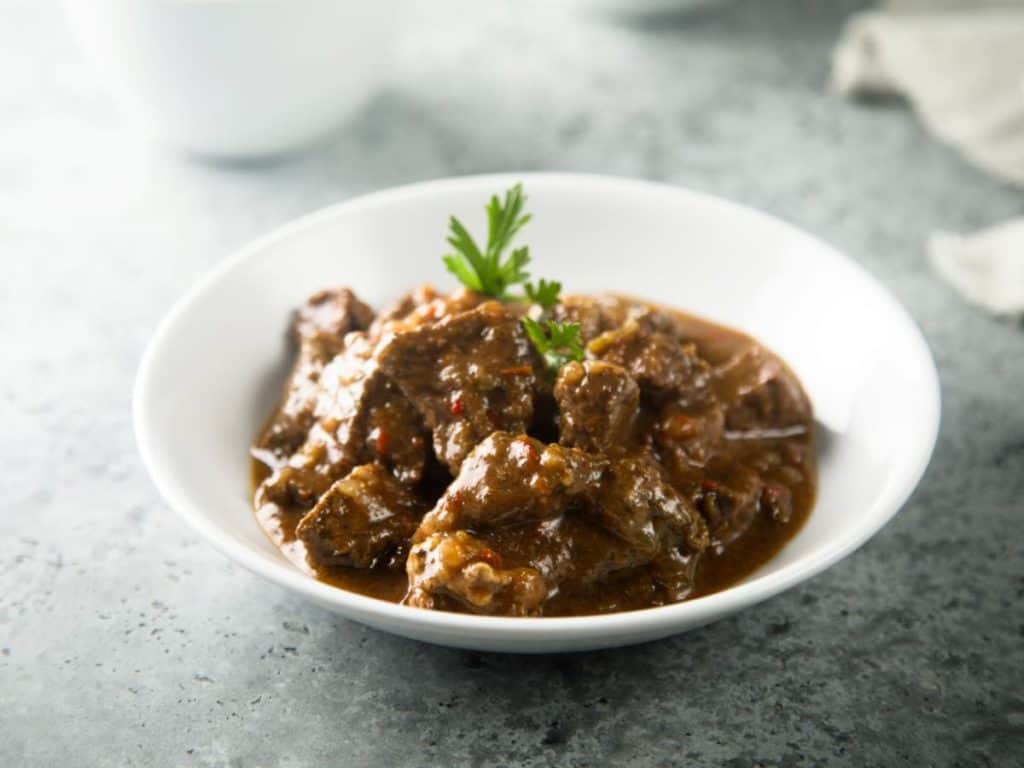
Malbec
Many chefs love Malbec as a cooking wine for the fact that it’s well-balanced — it has good volume and just the right amount of sweet tannins. What’s more, the dry red wine boasts of a variety of flavors, mostly dark- and red-colored fruits with notes of some minerals, without one overpowering the other.
It goes without saying that, because of its special characteristics, Malbec is versatile in the kitchen. However, it’s when cooking an assortment of exquisite beef dishes that this dry red wine truly shines.
Malbec first came into being in France. These days, however, it is considered an Argentinian type of red wine.
The inky black-blue grape variety used for making the product, which is also called Malbec, has a hard time growing in France. Meanwhile, it doesn’t seem to find thriving in Argentina a problem. It’s exactly due to this why as much as three-quarters of all vineyards in the South American country grow Malbec.
While Malbec is great for cooking various types of meat, it can bring out the best in beef the most. In many instances, it’s used for tenderizing and boosting the flavor of beef for grilling.
However, many hearty and saucy beef recipes also call for the addition of Malbec.
Can’t seem to get your hands on a bottle of Malbec? You can try replacing the dry red wine with Shiraz, although it has slightly more tannins than Malbec. Another alternative is Merlot, which you will find delightful when making tomato-based thick sauces and flavorful reductions. Tannin content-wise, Merlot is so much closer to Malbec than Shiraz.
These are some beef dishes that a little Malbec can make even richer and more delectable:
- Skirt steak fajitas
- Beef bourguignon
- Slow-braised beef
Grenache (or Garnacha)
Like Shiraz which is also sometimes referred to as Syrah, Grenache is also sometimes called Garnacha.
It all boils down to where the grape used for its production is grown. In France, the grape varietal is known as Grenache. Meanwhile, in Spain, it’s called Garnacha. Makers of Grenache or Garnacha red wine outside of France and Spain can freely decide which between the two names to use. But the bottom line is that they are one and the same.
One of the things that make Grenache a wonderful cooking wine is the fact that it’s dry — without being sweet, you can rest assured that it won’t alter the taste of your dish by neutralizing the key flavors.
Grenache is tannic, but not overly. As a matter of fact, it is often compared to Merlot in terms of the tannin content. Both red wine types have moderate amounts of tannins, which is why they can tenderize meat and, instead of making your culinary creation astringent, provide much-needed structure and balance.
It’s not uncommon for experienced chefs to use Grenache for cooking chicken, duck and turkey.
However, since Grenache is versatile in the kitchen, whether professional or domestic, it can also be used for cooking with many other types of meat. But being a dry red wine, it’s particularly perfect with beef. This is made even more so by the fact that it boasts of red fruit and mild peppery flavors, with floral and vanilla notes.
Check out these savory beef dishes that are best prepared with a dose of Grenache:
- Beef cannelloni
- Roast beef tenderloin
- Beef wellington with red wine sauce
Zinfandel
Many popular beef dishes call for the addition of bold red wines. One very good example is Zinfandel, which hails from California. The grape varietal used for its production, which shares the same name as the red wine, is grown in about 10% of all the vineyards in the Golden State.
Various dark-colored fruits will fill your mouth with every sip of Zinfandel. Some of them include blueberries, boysenberries, cranberries, plums and cherries. The fruity explosion is then followed by licorice and black pepper.
Its flavor profile also consists of a tobacco-like smoky finish.
The majority of Zinfandel in the wine market usually has soft tannins. However, you may come across a bottle whose tannin content can range anywhere from medium to medium-plus. So, when shopping for Zinfandel for cooking purposes, make sure that you carefully note what the recipe requires exactly in a red wine tannin-wise.
Acidic is one of the things that Zinfandel is known for, which is a good thing for those who are looking to serve phenomenal beef dishes at home. Because it’s kind of sweet, it goes really well with some of the most savory and spicy recipes out there. Not only is Zinfandel perfect for tomato-based sauces, but also numerous herb-based ones.
But there is no need to limit the use of Zinfandel to certain recipes. For as long as the one you wish to give a go asks for a red wine that’s bold, fruity and acidic, you can count on it.
Some of the beef dishes that a little Zinfandel can make extraordinary include:
- French beef stew
- Pan-seared steak with red wine sauce
- Red wine beef ragu
Just Before You Cook Beef With Dry Red Wine
Not all red wines are the same. Some are great only for sipping, while others are also perfect for cooking. Dry red wine varieties, such as the ones we talked about above, are the best for whipping up beef dishes. Choose well, and none of your family and friends will have a beef with your cooking!
Read Also: White or Red Wine With Pasta: Ultimate Guide



